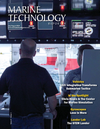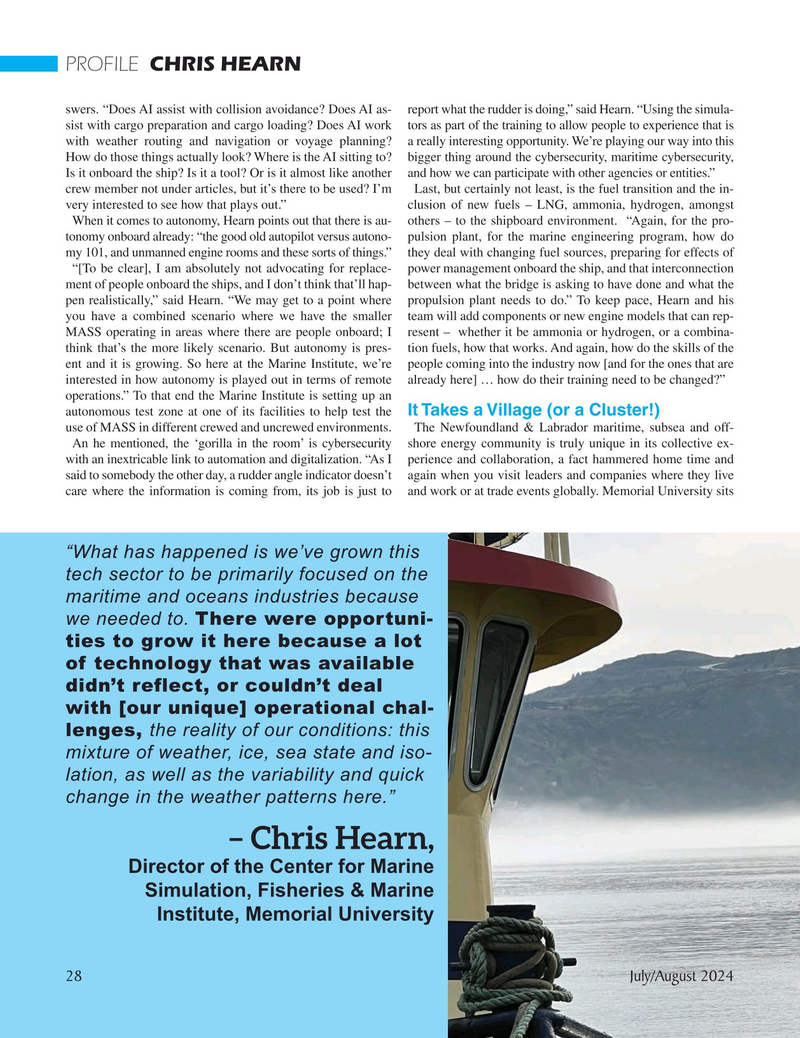
Page 28: of Marine Technology Magazine (July 2024)
Read this page in Pdf, Flash or Html5 edition of July 2024 Marine Technology Magazine
PROFILE CHRIS HEARN swers. “Does AI assist with collision avoidance? Does AI as- report what the rudder is doing,” said Hearn. “Using the simula- sist with cargo preparation and cargo loading? Does AI work tors as part of the training to allow people to experience that is with weather routing and navigation or voyage planning? a really interesting opportunity. We’re playing our way into this
How do those things actually look? Where is the AI sitting to? bigger thing around the cybersecurity, maritime cybersecurity,
Is it onboard the ship? Is it a tool? Or is it almost like another and how we can participate with other agencies or entities.” crew member not under articles, but it’s there to be used? I’m Last, but certainly not least, is the fuel transition and the in- very interested to see how that plays out.” clusion of new fuels – LNG, ammonia, hydrogen, amongst
When it comes to autonomy, Hearn points out that there is au- others – to the shipboard environment. “Again, for the pro- tonomy onboard already: “the good old autopilot versus autono- pulsion plant, for the marine engineering program, how do my 101, and unmanned engine rooms and these sorts of things.” they deal with changing fuel sources, preparing for effects of “[To be clear], I am absolutely not advocating for replace- power management onboard the ship, and that interconnection ment of people onboard the ships, and I don’t think that’ll hap- between what the bridge is asking to have done and what the pen realistically,” said Hearn. “We may get to a point where propulsion plant needs to do.” To keep pace, Hearn and his you have a combined scenario where we have the smaller team will add components or new engine models that can rep-
MASS operating in areas where there are people onboard; I resent – whether it be ammonia or hydrogen, or a combina- think that’s the more likely scenario. But autonomy is pres- tion fuels, how that works. And again, how do the skills of the ent and it is growing. So here at the Marine Institute, we’re people coming into the industry now [and for the ones that are interested in how autonomy is played out in terms of remote already here] … how do their training need to be changed?” operations.” To that end the Marine Institute is setting up an
It Takes a Village (or a Cluster!) autonomous test zone at one of its facilities to help test the use of MASS in different crewed and uncrewed environments. The Newfoundland & Labrador maritime, subsea and off-
An he mentioned, the ‘gorilla in the room’ is cybersecurity shore energy community is truly unique in its collective ex- with an inextricable link to automation and digitalization. “As I perience and collaboration, a fact hammered home time and said to somebody the other day, a rudder angle indicator doesn’t again when you visit leaders and companies where they live care where the information is coming from, its job is just to and work or at trade events globally. Memorial University sits “What has happened is we’ve grown this tech sector to be primarily focused on the maritime and oceans industries because we needed to. There were opportuni- ties to grow it here because a lot of technology that was available didn’t reflect, or couldn’t deal with [our unique] operational chal- lenges, the reality of our conditions: this mixture of weather, ice, sea state and iso- lation, as well as the variability and quick change in the weather patterns here.” – Chris Hearn,
Director of the Center for Marine
Simulation, Fisheries & Marine
Institute, Memorial University 28 July/August 2024
MTR #5 (18-33).indd 28 7/23/2024 1:59:25 PM

 27
27

 29
29
